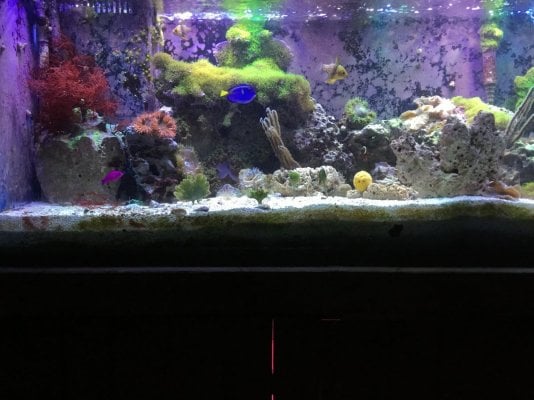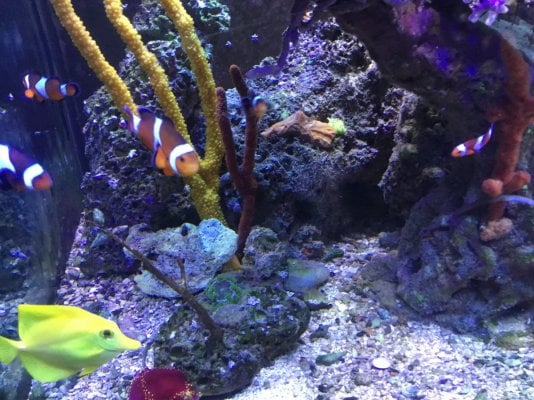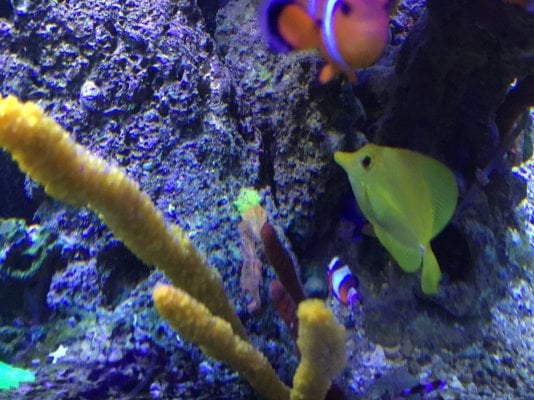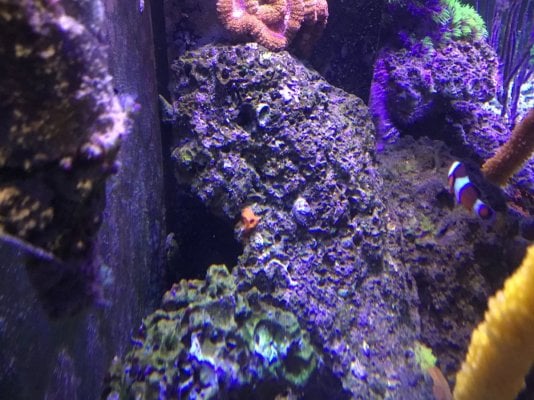Navigation
Install the app
How to install the app on iOS
Follow along with the video below to see how to install our site as a web app on your home screen.
Note: This feature may not be available in some browsers.
More options
You are using an out of date browser. It may not display this or other websites correctly.
You should upgrade or use an alternative browser.
You should upgrade or use an alternative browser.
Nutrient Management by “Old School” Reefer
- Thread starter Subsea
- Start date
-
- Tags
- if it aint broke
- Tagged users None
@HuduVudu I do need to stress this...
I certainly realize that I could reduce the fish population, increase the live rock volume, and leave my tanks alone to let nature find it's balance with great success. What my focus over the past year or so has been, is to find artificial ways to boost the biological load capacity of my tanks without using a large volume of live rock. That goal really doesn't fit into the Trident Method as I understand it, as the Trident requires a given volume of live rock for a given tank size.
My goal is a lot of fish, a little bit of rock, and a muscular filtration system that appropriately compensates for my selfish desires for fish and minimal decor. Good luck, right!!!???
I never bought into lots of live rock for biofiltration. I get uncured diver collected live rock to introduce diversity. I use a 2” sandbed with a plenum and operate it as a reverse flow. The plenum is a Cryptic Refugium and the sandbed is full of oxygen loving detrivores. Combine that with a powerful algae filter and you can add a large fish load.
No doubt you can load up fish and remove all rock. Reef fish need cover and hiding places. Stress kills fish.
Having a bit of a higher nitrate issue (15 - 20 ppm), I decided to give light carbon dosing with vinegar a try...without using a skimmer. It successfully brought my nitrates down to 2-3 ppm. Export of excess bacteria was via WCs and regular gravel vacuuming, but it sure caused some heavy bacterial buildup in the pump and plumbing along with a white-ish dusting on my grass every 2-3 days. As expected, film algae was non-existent during this treatment (nearly 2 months).
While an interesting exercise, I have no plans for trying this again. I can keep NO3 stable by simply adjusting my feeding and doing a bit more aggressive maintenance.
What I don't know is how the sustained additional quantities of acetic acid might change a microbial community long term (if at all). My assumption is that once the additional source of carbon has been removed, the community would rebalance back to it's former state.
While an interesting exercise, I have no plans for trying this again. I can keep NO3 stable by simply adjusting my feeding and doing a bit more aggressive maintenance.
What I don't know is how the sustained additional quantities of acetic acid might change a microbial community long term (if at all). My assumption is that once the additional source of carbon has been removed, the community would rebalance back to it's former state.
Last edited:
If you have some good pics or a drawing/sketch of your sandbed/plenum setup, I would love to see it and learn.I never bought into lots of live rock for biofiltration. I get uncured diver collected live rock to introduce diversity. I use a 2” sandbed with a plenum and operate it as a reverse flow. The plenum is a Cryptic Refugium and the sandbed is full of oxygen loving detrivores. Combine that with a powerful algae filter and you can add a large fish load.
No doubt you can load up fish and remove all rock. Reef fish need cover and hiding places. Stress kills fish.
If you have some good pics or a drawing/sketch of your sandbed/plenum setup, I would love to see it and learn.
The concept came from Old School cichlid fish keepers.
@Paul B may have a picture when he moved his 47 year old tank.
Above is a standard ug plate with two uplift tubes powered by air pump. With that arrangement, water is drawn down into sandbed. Reverse the flow, with a pump into plenum and up thru sandbed. This helps to prevent clogging sandbed with ditritous.
I used eggcrate light diffuser with fiberglass window screen mesh on top of eggcrate. Use 1/2” PVC on its side to create void space of plenum. When sizing eggcrate, leave 1” from edge of glass to allow screen to be tucked in. This same 1” gap allows pump discharge plumbing to be run to center of plenum. The gap also hides eggcrate and nylon mesh so you only view substrate. Cover everything with 1”- 2” of aroggonite substrate.
Last edited:
I need macro algae or sea grass, and alot of sponges. Thanks for the info.
OMG I have been meaning to write a post about this. I think that tangs in particular powder blue, powder brown and blue have a problem with sleeping. I have the butterfly equivelant of these fish (Pakistani) and he is so nuerotic he won't sleep at night unless I totally cover the tank. I remember several night dives and the darkness is actually frightening. I am starting to come to the understanding that certian fish need absolute pitch black to sleep, and if they don't get it they stress out and then become much more prone to infection.Reef fish need cover and hiding places. Stress kills fish.
I never bought into lots of live rock for biofiltration. I get uncured diver collected live rock to introduce diversity. I use a 2” sandbed with a plenum and operate it as a reverse flow. The plenum is a Cryptic Refugium and the sandbed is full of oxygen loving detrivores. Combine that with a powerful algae filter and you can add a large fish load.
No doubt you can load up fish and remove all rock. Reef fish need cover and hiding places. Stress kills fish.
I think at a certain point the amount of rock in your tank becomes a hinderance. I think balance for sure. Also at the end of the day it is not the rock but the stuff on the rock that is really bringing the biodiversity.
@Subsea is describing a reverse flow undergravel filter. These aren't exactly like plenums but work much the same way.If you have some good pics or a drawing/sketch of your sandbed/plenum setup, I would love to see it and learn.
I prefer the Jaubarts because I was tramatized in the 80's by the term undergravel filter.
When I had my digester up I suspected that it was doing carbon dosing. I wasing feeding the digester 2 balls of hamburger daily. I got the white film algae. After I took the digester off the film went away and the tank returned back to "normal". I don't think that you will have any issues long term.Having a bit of a higher nitrate issue (15 - 20 ppm), I decided to give light carbon dosing with vinegar a try...without using a skimmer. It successfully brought my nitrates down to 2-3 ppm. Export of excess bacteria was via WCs and regular gravel vacuuming, but it sure caused some heavy bacterial buildup in the pump and plumbing along with a white-ish dusting on my grass every 2-3 days. As expected, film algae was non-existent during this treatment (nearly 2 months).
While an interesting exercise, I have no plans for trying this again. I can keep NO3 stable by simply adjusting my feeding and doing a bit more aggressive maintenance.
What I don't know is how the sustained additional quantities of acetic acid might change a microbial community long term (if at all). My assumption is that once the additional source of carbon has been removed, the community would rebalance back to it's former state.
@Subsea is describing a reverse flow undergravel filter. These aren't exactly like plenums but work much the same way.
I prefer the Jaubarts because I was tramatized in the 80's by the term undergravel filter.
I operated a Jaubert Plenum for 22 yrs with a 6” sandbed of 1-2mm aroggonite . At the time, denitrification by facultative bacteria was the goal.. The coarser substrate extended the low oxygen zone to maximize denitrification., but it also allowed detritus accumulation due to insufficient sandbed maintenance. Previously, I had relied on sandbed detrivores but to my constanation, a Melanurus Wrasse destroys my janitor population over a two year period.
Because denitrification is not my desired goal, I reduced sandbed depth to 2” and created a slight positive pressure in plenum void using oxygen rich tank water.
Attachments
I think it would have been so cool if we could have kept at least a couple of those Aliens like in an "AO" Specific tank (Alien only)PS. In the movie, War of the Worlds, the invading Martians were finally killed by Earth’s “microbial overlords”.
Nowadays, with the addition of so many products to 'fix anything' (and so little known about possible long term consequences to the microbial communities)...let's just say that things are 'different' and leave it at that.
You mean we are supposed to add things besides water!!!!!
Atoll my friend, is that why there are so few blondes in the UK?I recall buy a 10 litre drum I think it was of 70% hydrogen peroxide and sharing it with my friend. It was sold by swimming pool suppliers to kill algae in outdoor ponds. Now you need a licence here in the UK to buy it.
Here my Son N Law is lifting my UG filter plates in my tank in preparation for it's move to my new home 60 miles away. That plate was in there for 40 years at the time. All I did was remove the Godzilla Larvae and throw everything into my new tank here.@Paul B may have a picture when he moved his 47 year old tank.

Subsea, great thread. Most of it is over my head so I stood on a bucket when I read it so I could absorb it better.
U
User1
Guest
View BadgesI never bought into lots of live rock for biofiltration. I get uncured diver collected live rock to introduce diversity. I use a 2” sandbed with a plenum and operate it as a reverse flow. The plenum is a Cryptic Refugium and the sandbed is full of oxygen loving detrivores. Combine that with a powerful algae filter and you can add a large fish load.
No doubt you can load up fish and remove all rock. Reef fish need cover and hiding places. Stress kills fish.
Having used both I will never use dry rock again. The reason being is that while dry rock can be used it takes two to three years if not more to mature. By mature I mean fully mature with whatever Mother Earth does to it while it is under water like quality live rock from say TBS.
I have used live Fiji sourced rock when we could get it and recently 170 lbs of dry pukani. I'm almost on my third year with the pukani and I can still take a piece of rock, lift, turn 90 degrees if not more, and it will look like I just unboxed it and placed it in the tank. To further emphasis on this I can take a larger boulder out, split it in half, and again it looks like I breached low earth orbit, went to the moon to collect the rock, and return it home to my tank.
Pukani rock, and maybe this is unique to it but I doubt it, is very porous with a lot of deep nooks and crannies that it takes years to get bacteria, algae, film, and whatever else to attract micro fauna. I'm not just talking about the bristle worms and pods but the tiny stuff hair size or smaller micro. With the rock being dead, porous, and what have you it just takes time. I do not see anything in those nooks and crannies. Just wasted space.
I can grow corals be it soft, lps, or sps. I can also keep the water chemistry somewhat stable. I can get my skimmer to produce that ever loving sweet smell of a low tide walk on the ocean beach my wife so loves to call it. Thick yuckie gunk on the neck and in the cup (and I only have 5 fish in my 210 gallon). But if you are to ask me if the rock is mature I'd answer no.
Sort of like being stuck on a deserted island looking for love. If you didn't bring it you won't find it. Sort of my relationship with dry rock
Outstanding thread!!! I've been running my skimmer drier and drier over that past year and a half, to the point I clean it out only every 3 months or so. I've even noticed my corals and fish look more healthy (my clowns and mandarins now breed on a weekly to monthly basis) with less skimming. I just cranked my skimmer up to produce wet skimmer but now installed a tube running from the bottom of the cup to the return pump. I'm hoping this helps oxygenate and feed my softie dominated tank...
Having used both I will never use dry rock again. The reason being is that while dry rock can be used it takes two to three years if not more to mature. By mature I mean fully mature with whatever Mother Earth does to it while it is under water like quality live rock from say TBS.
I have used live Fiji sourced rock when we could get it and recently 170 lbs of dry pukani. I'm almost on my third year with the pukani and I can still take a piece of rock, lift, turn 90 degrees if not more, and it will look like I just unboxed it and placed it in the tank. To further emphasis on this I can take a larger boulder out, split it in half, and again it looks like I breached low earth orbit, went to the moon to collect the rock, and return it home to my tank.
Pukani rock, and maybe this is unique to it but I doubt it, is very porous with a lot of deep nooks and crannies that it takes years to get bacteria, algae, film, and whatever else to attract micro fauna. I'm not just talking about the bristle worms and pods but the tiny stuff hair size or smaller micro. With the rock being dead, porous, and what have you it just takes time. I do not see anything in those nooks and crannies. Just wasted space.
I can grow corals be it soft, lps, or sps. I can also keep the water chemistry somewhat stable. I can get my skimmer to produce that ever loving sweet smell of a low tide walk on the ocean beach my wife so loves to call it. Thick yuckie gunk on the neck and in the cup (and I only have 5 fish in my 210 gallon). But if you are to ask me if the rock is mature I'd answer no.
Sort of like being stuck on a deserted island looking for love. If you didn't bring it you won't find it. Sort of my relationship with dry rock
Let’s frame this post for posterity.
Thank you for making me laugh,
“Sort of like being stuck on a deserted island looking for love. If you didn't bring it you won't find it.”
U
User1
Guest
View BadgesLet’s frame this post for posterity.
Thank you for making me laugh,
“Sort of like being stuck on a deserted island looking for love. If you didn't bring it you won't find it.”
Laughter is always good
Anyway on to the rock. Here are a few examples. The one with the Coral Beauty is 3 months after cycle with lights on, skimmer running, etc. I let the tank cycle an extra three months after it processed 4 ppm ammonia to 0 in under 12 or so hours. Tank was setup with 170 lbs of dry pukani. The one ugly full tank shot was about one year in. I had moved a 40 breeder into the 210 upgrade but lost a lot of corals. I think looking back is that it was directly due to the difference of a 10 or so year old tank (29 gallon tank split to two 29 gallons, then merged into a 40 breeder) to the larger tank with all of that new pukani rock.
The last image is from a photo maybe 3 months ago. The one with the green pally and clown. That coral up front is now green - was tan/white. Nitrates reached 0 so now dosing them. In any case the rock is covered with coralline algae but a lot of the nooks and crannies are still white/tan look as the one with the blenny. Interesting enough that bubble tip is actually shrinking now with the only thing being off is nitrates 0 to 5 ppm range.
I don't know. I just really dislike the dry rock / stuff as if you couldn't tell
No shortage of blondes in the UK Paul we just keep them hidden and under lock and key.
@Paul B was thinking about “Super Models”.
@atoll
With respect to 70% h202, I used to think that I was
“thick skinned” until I go some 30% peroxide on skin. I can only imagine 70%.
With respect to your oxygenator, do you know if consumption is higher at different times of day, like lights out on display tank.
Laughter is always goodI wish I could claim credit for it but it was movie night last night and my wiser half and I watched Six Days and Seven Nights. I probably had the quote wrong but that was more or less it
Anyway on to the rock. Here are a few examples. The one with the Coral Beauty is 3 months after cycle with lights on, skimmer running, etc. I let the tank cycle an extra three months after it processed 4 ppm ammonia to 0 in under 12 or so hours. Tank was setup with 170 lbs of dry pukani. The one ugly full tank shot was about one year in. I had moved a 40 breeder into the 210 upgrade but lost a lot of corals. I think looking back is that it was directly due to the difference of a 10 or so year old tank (29 gallon tank split to two 29 gallons, then merged into a 40 breeder) to the larger tank with all of that new pukani rock.
The last image is from a photo maybe 3 months ago. The one with the green pally and clown. That coral up front is now green - was tan/white. Nitrates reached 0 so now dosing them. In any case the rock is covered with coralline algae but a lot of the nooks and crannies are still white/tan look as the one with the blenny. Interesting enough that bubble tip is actually shrinking now with the only thing being off is nitrates 0 to 5 ppm range.
I don't know. I just really dislike the dry rock / stuff as if you couldn't tell



I am going to propose a parallel universe to @Lassie Method, I call it Laissez Faire Method
Use ammonia to establish a powerful nitrogen cycle bacteria population in sandbed. Then get uncured diver collected rock from Gulf of Mexico. Maximize air gas exchange and provide brisk water circulation. Before putting rock in tank, remove unwanted macros, as there are plenty of variety. Unless sponges show obvious distress, I leave them on rock during the curing process. If an oxygen meter is available, it’s a good tool to evaluate how things are doing. BOD will be very high and air bubblers are an easy thing to add. Expect Amphipods & copepods but there should be so much more diversity. Use moderate light intensity on a reduced light schedule of 8-10 hrs. After a few weeks, when film algae is abundent to support snails get some. The only fish to get for 6 months is an algae Blenny.
With the abundent diversity on this live rock, I instantly had SPS, NPS, Gorgonians, Bryozones of many colors and so many filter feeders. Sadly many died because I did not feed them what they needed. Yet, others like yellow ball sponge and orange bryozoans recently appeared on rock after 3 years in tank. I have also rotated rock in tank and found new growth on the side out of view. With live rock of this quality, I allow for open spaces so each rock can develop its own fauna & fana for maximum diversity.
Attachments
Similar threads
- Replies
- 6
- Views
- 224
- Replies
- 18
- Views
- 477
- Replies
- 58
- Views
- 1,159























